 This picture published by the Daily, "Rising Kashmir" (Courtesy Mir Imran) on August 21st, 2008 showing hooligans and rioters in Jammu pelting stones at Jammu and Kashmir Police (not in pic) as paramilitary CRPF personnel act as mute spectators to the whole event and enjoy the friendly match. This picture says a thousand words and reflects the real face of government apathy and inaction at Jammu against hindu hooligans whereas in Kashmir these very CRPF troopers shower bullets on peaceful protestors and massacre them in large numbers without any second thoughts. Is this what Jammu people decry as "Discrimination" against them ? These very rioters on August 20th, 2008 attacked several government buildings, damaged numerous vehicles and even torched many police posts without any retaliation from police. The reason cited towards this police inaction by a senior police official was that these rioters carry national flags and do not demand secession from India. BJP leader L.K. Advani declared these rioters as nationalists and all Kashmiris as secessionists, hence bullets for the latter and support for the former. This is frustation and discrimination at its best.
This picture published by the Daily, "Rising Kashmir" (Courtesy Mir Imran) on August 21st, 2008 showing hooligans and rioters in Jammu pelting stones at Jammu and Kashmir Police (not in pic) as paramilitary CRPF personnel act as mute spectators to the whole event and enjoy the friendly match. This picture says a thousand words and reflects the real face of government apathy and inaction at Jammu against hindu hooligans whereas in Kashmir these very CRPF troopers shower bullets on peaceful protestors and massacre them in large numbers without any second thoughts. Is this what Jammu people decry as "Discrimination" against them ? These very rioters on August 20th, 2008 attacked several government buildings, damaged numerous vehicles and even torched many police posts without any retaliation from police. The reason cited towards this police inaction by a senior police official was that these rioters carry national flags and do not demand secession from India. BJP leader L.K. Advani declared these rioters as nationalists and all Kashmiris as secessionists, hence bullets for the latter and support for the former. This is frustation and discrimination at its best.Thursday, August 21, 2008
Discrimination at its Best
 This picture published by the Daily, "Rising Kashmir" (Courtesy Mir Imran) on August 21st, 2008 showing hooligans and rioters in Jammu pelting stones at Jammu and Kashmir Police (not in pic) as paramilitary CRPF personnel act as mute spectators to the whole event and enjoy the friendly match. This picture says a thousand words and reflects the real face of government apathy and inaction at Jammu against hindu hooligans whereas in Kashmir these very CRPF troopers shower bullets on peaceful protestors and massacre them in large numbers without any second thoughts. Is this what Jammu people decry as "Discrimination" against them ? These very rioters on August 20th, 2008 attacked several government buildings, damaged numerous vehicles and even torched many police posts without any retaliation from police. The reason cited towards this police inaction by a senior police official was that these rioters carry national flags and do not demand secession from India. BJP leader L.K. Advani declared these rioters as nationalists and all Kashmiris as secessionists, hence bullets for the latter and support for the former. This is frustation and discrimination at its best.
This picture published by the Daily, "Rising Kashmir" (Courtesy Mir Imran) on August 21st, 2008 showing hooligans and rioters in Jammu pelting stones at Jammu and Kashmir Police (not in pic) as paramilitary CRPF personnel act as mute spectators to the whole event and enjoy the friendly match. This picture says a thousand words and reflects the real face of government apathy and inaction at Jammu against hindu hooligans whereas in Kashmir these very CRPF troopers shower bullets on peaceful protestors and massacre them in large numbers without any second thoughts. Is this what Jammu people decry as "Discrimination" against them ? These very rioters on August 20th, 2008 attacked several government buildings, damaged numerous vehicles and even torched many police posts without any retaliation from police. The reason cited towards this police inaction by a senior police official was that these rioters carry national flags and do not demand secession from India. BJP leader L.K. Advani declared these rioters as nationalists and all Kashmiris as secessionists, hence bullets for the latter and support for the former. This is frustation and discrimination at its best.
Subscribe to:
Post Comments (Atom)














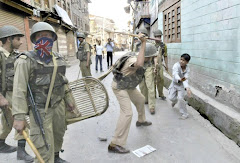





















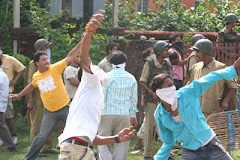

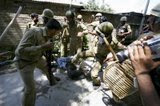




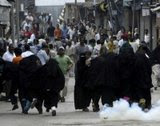







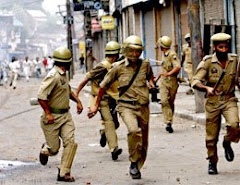
The Economics of Economic Blockade
ReplyDeleteCourtesy: Daily Greater Kashmir dt. Sep., 9th, 2008
STUDYING THE CASE
To understand the phenomenon we must do an analysis of Regional Losses, writes Prof. Nisar Ali.
All the three regions, Jammu, Kashmir and Ladakh complain of discrimination. The development scenario and consequential state interventions have given birth to a great public upheaval in this regard. The State appointed various commissions and committees to examine the claims and counter claims who submitted their reports to the government. Mention may be made of Dr P.B. Gajindergadkar Commission, 1967, Justice Sikri Commission, 1979, Development Review Committee under the Chairmanship of L.K.Jha and so on. While many of the recommendations made by various commissions from time to time accepted by the government and were pressed in to service, but the perceptions did not undergo a change among the people in the three regions, hence the problem resurfaces in one form or the other underlying certain catalytic forces.
Looking at Census 2001, out of a little over 10.01 million populations 44.3 comprise Jammu region, 54 per cent Kashmir region and 2.33 per cent live in Ladakh region. Based on an annual rate of growth of population between 1981 - 2001 and assuming the same rate to hold, the population has increased to 11.8 million in 2007 in which the share of Jammu region stand 51.85 per cent and Kashmir and Ladakh region comprise 64.10 per cent and 2.77 percent respectively. The entire economic activity generated by development sectors of state economy can be condensed into an economic magnitude called gross state domestic product, that is, state income which stands Rs 24.8 thousand crore at current prices with per capita income Rs. 22506 (2006-07). The share of Jammu region in GSDP at current prices (2004-05) stands 44.32 percent against its population share of 51.85 per cent and that of Kashmir region 53.14 percent against its population share of 64.10. The share of Ladakh region stands 2.54 percent against its population share of 2.54 per cent. Thus the discrepancy between income-population shares is 7 percent in Jammu, 11 percent in Kashmir and 0.23 percent in Ladakh. The intra-regional income disparity, in aggregative terms, reduces to zero as proportion of population and incomes coincide or tend to zero. The inequitability of GSDP distribution is relatively more in case of Kashmir region and less in Jammu while Ladakh by and large tends to have equitable distribution of aggregate income. We can see from the table below that the allocation of plan funds under the district sector, the allocation satisfies the canon of equity and taking population into account the per capita plan expenditure (2006-07) stands Rs 765 for Kashmir, Rs. 991 for Jammu and Rs 5,880 for Ladakh region. Another macroeconomic aggregate is credit-deposit ratio in the regions under reference. While the aggregate deposits in Jammu region are about 50 per cent of the total deposits, the advances in the region are about 35 per cent in spite of the industrialisation in the region. The credit-deposit ratio in the region is very low compared to 65.4 in Kashmir.
The net area sown (NAS ) is about 8 percent higher in Jammu region than Kashmir region and percentage of holdings less than 10 Kanals size are 60.56 per cent in Kashmir region while the said percentage in Jammu region stands 41.81, that is, subsistence farms are 19 percent higher in Kashmir than Jammu. The forest cover is mostly in Jammu region, almost 98 percent of the total forest area in the state providing an opportunity for forest based industries. The district plan expenditures are almost equal between Jammu region and Kashmir in spite of population difference of 12 percent. The capacity building reckoned with in terms of capital component of plan expenditure is almost equal.
If we look at general literacy region-wise as per Census 2001, Kashmir is far behind having regional literacy 41.84 percent as against 53.86 percent in Jammu region and 54.57 percent in Ladakh region. The Jammu region has a greater share in states bovine economy with livestock 66.73 percent, as against Kashmir region 26.69 percent and 6.58 percent in Ladakh. The industrialisation has taken place mostly in Jammu region due the location advantages. Among the state’s 48 thousand small scale registered industrial units 50.08 percent are in Kashmir with total employment of 46.90 percent, while Jammu has 46.77 per cent industrial units under the said category with 51.46 percent employment. The percentage of units in Ladakh region stands 3.15 with 1.64 percent employment. Similarly, the Economic Census 2005 shows that there are 56.17 percent economic enterprises in Kashmir, 40.63 percent in Jammu and 3.2 percent in Ladakh providing employment to people in the state with percentage break-up as 55.56 in Kashmir, 40.63 in Jammu and 3.51 in Ladakh. The economic and statistical profile is presented over here briefly to assess the development disproportions in terms of accepted indicators of the regions under reference in the state.
Regional Industrial Potential and Industrialisation
Mostly the industries have come up in Jammu region as compared to Kashmir due to rail head and location advantage. In addition to these comparative advantages Jammu region has strong mineral resource base which may be briefly mentioned over here:
The industrial policy pressed in to service in 2004 provided fiscal and tax incentives for industry and one Udyog Bhavan is coming up at Jammu with Rs 14.7 lakhs over a built up area of 1.10 lakh sq feet. The other one is being proposed at Srinagar. The contribution of registered manufacturing sector to state domestic product is 56.9 percent from Jammu and 43.10 percent from Kashmir region. The industries like steel fabrication, pharmaceuticals and other consumer goods which emerged over the years have assured domestic market in Kashmir valley.
Economic Implications of Economic Blockade
Given the above mineral manufacturing industry base, most of the goods manufactured in Jammu find outlet to Kashmir and it is not only confined to manufacturing but in intra-regional trade grains (Basmati), vegetables and other consumer products have assumed an important place.
On the other hand the exports comprising orchard products and little handicrafts constitute intra-regional trade between the two regions. Out of 1.5 million metric tonnes production of fresh and dry fruit, 50 percent constitute inter-state trade while more than half of the remaining 50 per cent comprise inter-regional trade between Kashmir and Jammu benefitting Jamuite mercantile intermediaries. Out of the 50 per cent domestic consumption, given the magnitude of Jammu pilgrim tourism, 70 percent of fruit is sold in Jammu worth RS. 1,000 crore, if we put estimates on the lower side. The parent demand threshold is generated from pilgrim tourism (Vaishno Devi), that is, 7 million per annum. Out of the total production of traditional craft sector valued at Rs 950 crore (2006-07) 20 percent has retail outlet at Jammu. Therefore, within the intra-regional trade dynamics Jammu region appears to be more on economic loss. In the intra-regional trade matrix, the regional losses are considerable on account of export of Jammu manufactured products to Kashmir and business of Kashmir produced products in Jammu. The traffic movement of trucks and buses from Lakhanpur to Jammu is 5.58 lakhs, that is, 1,530 per day (2006-07), while from Jammu to Kashmir, the said movement stands 7.5 per day. Similarly, out of the total shop establishments of 58,349 in Jammu region, 20 percent are general provisions, 10 percent pertain to dress material and another 8.5 percent, readymade garments. These statistical estimates provide an evidence of possible volume of daily business transactions and the volume of employment (man-days) lost per day in the region.
Secondly the Jammu region being the main tax collection point (Lakhanpur), out of the total tax realization (excise and VAT) 75 per cent tax is collected in Jammu amounting to Rs 100 crore per day.
The loss to the state government revenue realization also can be enormous, thereby affecting fiscal distortion as well as suffering of development projects. Out of the total VAT almost 70 per cent is realised in Jammu region, thanks to growing volume of business and manufacturing in the region. Thus the public has to realise that the economic losses as a result of “economic blockade” are far larger for the society engineering the blockade than for the society for whom the blockade is effected. The economic activity, as mentioned above, generate about Rs 24 thousand crore as state income (2006-07) at current prices, that is, Rs 2000 crore per month or Rs 67 crore per day in the State from the view point of state income estimates. On the assumption of the state economy at stand still, the said loss would be experienced by the state in the form of recession or depression, hence neither the regional economies nor the state would be able to sustain the economy. On understanding the economic arithmetic, the intra-regional mutual understanding and cooperation would go a long way in mitigating the intra-regional problems.
Conclusion
Given the State on threshold of development with most of the macroeconomic magnitudes relatively dismal compared to All-India averages, the sustainable development can only be achieved through understanding economic implications of the present strife and intra-regional cooperation is the paramount for self-sustained growth.
(The author is professor of Economics, University of Kashmir, Srinagar. The views expressed are author’s personal and not attributed to the offices he holds.)
Kashmir incredibly discriminated:
ReplyDeleteA deep study of facts endorsing this feeling
By Dr. s. Bashir Ahmed Veeri
Courtesy: Daily Etalaat dt. Sep., 22nd, 2008
Top slots in administration are as under.
Administration, IAS, KAS CADRE
Total cadre strength of IAS is 94.
Kashmiri including pundits are 24. Jammuites all non Muslims are 27. From Ladakh are 02. Rest is outside state & number is 41 all are non Muslims. Since 1947 – out of 26 Chief Secretaries only 6 (six) were from Kashmir including Kashmiri Pandits.
All important departments are headed by non Kashmiri which include, Chief Secretary, Planning dept, finance, Roads & buildings, PHE & Irrigation, Agriculture, Revenue, Social Welfare, Health, Home, CAPD, Industries & Commerce, Information, PDD, Science & Technology, and Transport & Culture.
Out of 338 KAS officers
Kashmiri officers including pundits are 155. Officers from Jammu are 151. From Ladakh are 22. There are 10 junior KAS officers also.
Since 2001 till date, 478 KAS appointments were made which included only 106 from Kashmir.
360 KAS officers were appointed from Jammu & 12 are from Ladakh area. Within next five years majority KAS officers from Kashmir are retiring and 80 to 90% domination in the services will be from Jammu.
Let us examine some seniority lists of certain departments.
Junior agriculture assistants on April 2006: Total JAA were 1656
Agriculture Assistants from Jammu were 1015. From Kashmir were 641 only.
Similarly seniority list of AEE's 164 belong to Jammu & only 114 were from Kashmir.
Selection list of Accounts Assistants in April 2008,
Out of total 429 AA's, 334 were fro Jammu & only 95 were from Kashmir.
Police organisation, IPS, KPS & other services
Since its establishment in 1914, almost in last 100 years only two Kashmiri Muslims, Peer Gh Hassan Shah & Ghulam Jeelani Pandit headed the elite force, besides two kashmiri pundits including the present DGP Kuldip Khuda. Rests of the DGP's were either from Jammu or outside state. We have seven (7) senior officers of the rank of DIGP's.
Only two are Kashmir pundits & rest 5 are from outside state.
Among two ADGPs only one Dr Ashok Bhan belongs to Kashmir & another is from outside state.
Out of 22 IGP's, only four (4) belong to Kashmir, Five (5) are from Jammu & rest are from outside state.
Out of 20 DIGP's only five (5) belong to Kashmir, Eight (8) are from Jammu & rest are from outside state.
We have 62 SSP's within IPS cadre only 12 are Kashmiri, 21 are Jammuites & two are from Ladakh. However 27 are from outside state.
At the same time we have 139 KPS officers with the rank of SP's.
Only 46 are from Kashmir, 87 are Jammuites & three are from Ladakh.
Among 224 Dy.SP's 112 are from Kashmir, 108 are from Jammu region & only three are from Ladakh.
Out of 93 inspectors holding Dy.SP's post only 37 are Kashmiris while as 55 are from Jammu & one from Ladakh.
Judiciary
Another important arm of governance & watch dog of justice is judiciary.
HIGH COURT LEVEL
Out of 10 high court judges, only 03(three) are Kashmiri, 03 are from Jammu, one Kashmiri Pandit & three are from outside state.
Although J&K high court bench gives six slots each to Kashmir & Jammu of these two judges from Jammu, justice V K Gupta & justice T S Thakur are already chief justice posted on deputation & justice Bilal Nazki is posted at Bombay high court.
The state high court has so far sent three judges to Supreme Court, one of whom justice A S Anand served as chief justice of India & other two were justice Jaswant Singh & R P Sethi all the three from Jammu.
SESSION COURT LEVEL
Out of 64 session judges in state, only 24 are Kashmiri, 08 are Kashmiri Pandits, 04 are Jammu Muslims & 28 belong to Jammu.
16 out of 24 Kashmir Muslim judges are retiring in next two years.
MUNSIF COURT LEVEL
Out of 110 sub judges/Munsiff, only 29 are Kashmiri Muslims, 02 are Pandits & 79 belong to Jammu.
Can you still count it discrimination?
If we compare with other states, demographic pattern of state has close resemblance with West Bangal, that is Hindu population there is 72.5% & Muslims are 25.2%. Whereas J&K has 68% Muslim & 29% hindu population. In west Bengal share of Muslims is 4.8% at the level of session judges & 3.2% at level of munsiffs & same is the case with other wings of Govt. Reverse is case here despite being a Muslim majority state.
Plan expenditure & taxes
Prime Ministers rehabilitation package under healing touch policy was much celebrated for elevating the decades suffering of Kashmir due to militancy & reconstructing damaged infrastructure, creating new avenues for employment to counter militancy & bring youth to main stream in Kashmir.
Rs 24,000 crores package was announced which was later on enhanced to Rs 29,000 crores. This infrastructural package on the name of Kashmir was spent as under :
Only Rs 6448 crores were given to Kashmir.
A whooping amount of Rs 12531 crores were allotted to Jammu & Rs 2805 crores were given to
Ladakh
The remaining amount was diverted to state level sectors & projects such as transmission & distribution, Mughal road, ADB- counterpart funding & figure stands to Rs 8929 crores. During last two decades of militancy in Kashmir region Jammu got massive diversion of funds due to non utilization in Kashmir due to disturbance.
Another important industrial package of Rs 5000 crores for Kashmir was announced to generate employment and to boast dead and non-existing industries of Kashmir region which suffered heavy losses during past 16 years of militancy, with impressive incentives to entrepreneurs in the form of excise and sales tax refund.
For 2006-07,excise refund stands 950crore and Kashmir gets only Rs 90 crore ,rest is taken by Jammu.
Sales tax refund stands at Rs 400 crore per year and Kashmir component is less than 40 crore, rest is taken by Jammu.
The whole sale depots and C& F company depots are shifted to Jammu on grounds of disturbance in the valley, they serve the consumer market in Kashmir & Rs 200 crore are collected annually as sales tax alone in Jammu but paid by dealers from Kashmir which is counted in the basket of tax collection of Jammu.
Plan expenditure is 14% per capita more in Jammu division than in Kashmir region. In the last two years under central road fund, number of schemes sanctioned to Jammu stands at 13 with involved cost of Rs 205 crore & Kashmir gets just TWO with involved cost of Rs 24 crore only.
Under PMGSY (Prime Ministers Gram Sadak Yojana) the number of schemes sanctioned to Jammu stands at 423 with allotted cost of Rs 1405 crore & the length of all road scheme being 2967 kms.
Whereas Kashmir got only 414 schemes with an allotted cost of Rs 687.26 crores & the length of all roads in all schemes is 1451 kms.
Planning commission of India made comprehensive district wise profile based on certain indicators of development in the J&K state. Agriculture is the only area where Kashmir tops as traditionally agriculture is backbone of society & economy of Kashmir due to rich natural water resource, fertility of soil & favourable climatic conditions.
On Social sector development, Jammu stands at number one followed by Khatua, Leh & Srinagar at number 04. Though Srinagar is not a modern urban conglomerate. It has been reduced to a second class town lacking all modern facilities a state capital requires.
On infrastructural development front again Srinagar ranks 04 & Jammu is at number one. On the economic development index both the capitals are placed equally.
When composite index of development is taken which is average of all the developmental indices of agriculture, social, infrastructural & economic again Jammu stands at number one & Srinagar at number two.
Honestly one has to admit that Jammu certainly is better place to live in. Metropolitan infrastructure, international standard roads, shopping malls, clean hospitals, international level Jammu university auditorium and so many other facilities make Jammu much more attractive than Srinagar.
On the basis of comparative merit it is seems that practically Kashmir have been discriminated but one has to be pragmatic and not get swayed by emotionalism & join the Bandwagon of hue & cry which does not serve any purpose rather becomes counterproductive both for region as well for state.